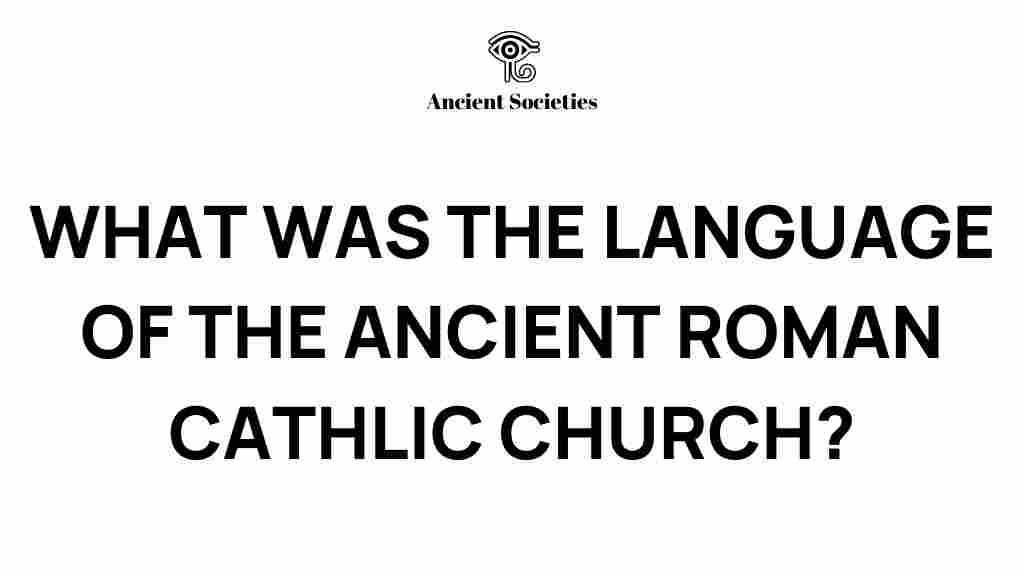Unveiling the Language of the Ancient Roman Catholic Church: Latin
The Roman Catholic Church, with its rich and intricate history, has long been associated with the use of Latin. This ancient language plays a crucial role in ecclesiastical traditions, rituals, and the preservation of cultural heritage. In this article, we will explore the significance of Latin within the Roman Catholic Church, its historical context, its use in church rituals, and its impact on religious texts. Join us as we unveil the fascinating relationship between Latin and the ancient Roman Catholic Church.
The Historical Context of Latin in the Roman Catholic Church
Latin, an ancient language that originated in the Roman Empire, became the official language of the Roman Catholic Church during the early centuries of Christianity. Understanding the history of language in this context is vital to appreciating its role today. Here’s a brief overview:
- Origins: Latin was the language of the Romans, used in administration, literature, and law.
- Christian Adoption: Early Christian writings began to be composed in Latin, notably the Latin Vulgate translation of the Bible by St. Jerome in the late 4th century.
- Ecclesiastical Latin: As Christianity spread, Latin evolved into what we now refer to as ecclesiastical Latin, which is characterized by its pronunciation and vocabulary tailored for liturgical use.
Latin in Church Rituals
The use of Latin in church rituals has been a defining feature of the Roman Catholic Church for centuries. Here are some key points regarding its significance in worship:
- Uniformity: Latin provides a uniform language for the celebration of Mass and the sacraments, ensuring that the same prayers and responses are understood globally.
- Timelessness: The use of Latin allows rituals to transcend time and cultural changes, preserving the integrity of traditional practices.
- Liturgical Texts: Many of the Church’s most important texts, such as the Missal and the Breviary, are composed in Latin, which continues to be used in solemn ceremonies.
Religious Texts and Latin
Latin has been instrumental in the preservation and transmission of religious texts within the Roman Catholic Church. Here’s how:
- Biblical Translations: The Latin Vulgate became the standard version of the Bible in the Western Church and remains significant in Catholic liturgy.
- Theological Works: Many foundational theological texts were written in Latin, including the works of Church Fathers and scholars like Augustine and Aquinas.
- Preservation of Doctrine: The use of Latin has helped maintain clarity and consistency in Church teachings over the centuries.
Cultural Heritage of Latin in the Roman Catholic Church
Latin is not merely a language; it is a vital component of the cultural heritage of the Roman Catholic Church. Its influence extends beyond the walls of the church and into the broader cultural context:
- Art and Music: Many renowned works of art and music, including compositions by Palestrina and Mozart, are deeply rooted in Latin texts.
- Education: Latin has been a cornerstone of education in the Church, with many seminaries and institutions emphasizing its study.
- Legal Language: Canon law, which governs the Church, is composed in Latin, reflecting its ongoing relevance in Church governance.
The Transition to Vernacular Languages
While Latin has held a prominent position in the Roman Catholic Church, the Second Vatican Council (1962-1965) marked a significant shift towards the use of vernacular languages in liturgy. This change aimed to make the Mass more accessible to the faithful. Here are some key considerations:
- Increased Participation: The use of local languages has encouraged greater participation by the congregation during Mass and other rituals.
- Spiritual Understanding: Understanding prayers and readings in one’s native language enhances spiritual engagement and personal reflection.
- Retention of Latin: Despite the shift, Latin remains a vital part of the Church’s identity, especially during formal and traditional ceremonies.
Challenges and Troubleshooting Tips
While the transition to vernacular languages has been beneficial, it has not been without challenges. Here are some common issues and troubleshooting tips:
- Loss of Tradition: Some traditionalists feel that the use of vernacular languages diminishes the sacredness of the liturgy. To address this, parishes can incorporate Latin hymns and prayers during services.
- Understanding Latin: As Latin is not commonly spoken, many may find it challenging to engage with it. Offering classes or resources on ecclesiastical Latin can help bridge this gap.
- Balancing Languages: Finding a balance between Latin and vernacular can be difficult. Parishes can alternate between languages, ensuring that both traditional and contemporary elements are present.
Conclusion
Latin remains an integral part of the Roman Catholic Church, serving as a bridge to its ancient roots and a cornerstone of its cultural heritage. While the shift to vernacular languages has made the liturgy more accessible, Latin continues to hold a special place in the hearts of many Catholics and within the Church’s traditions. Understanding the role of Latin helps us appreciate the depth of the Church’s history, its rituals, and its texts.
As we look to the future, the challenge will be to honor the rich legacy of Latin while embracing the languages of the people. Whether through the solemnity of a Latin Mass or the vibrancy of a vernacular service, the essence of the Roman Catholic Church remains unchanged: a community of faith united in worship.
For more information on the history of language in the church, you can visit this external link. To explore more about ecclesiastical Latin and its current use, check out this internal link.
This article is in the category Culture and created by AncientSocieties Team
